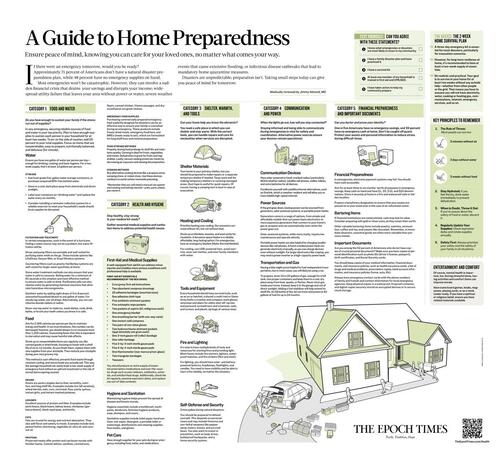Authored by Mikai Allbert via The Epoch Times (emphasis ours),
Two hurricanes have barreled through the Southeast in just two weeks. Hurricane Helene thrashed North Carolina, while Hurricane Milton—the most destructive storm to hit the Tampa area in a century—left more than 3 million without power and at least 10 people dead in Florida.

“[We] were not expecting a one-in-1,000 event,” one resident told our photographer and editor Richard Moore amid the wreckage. Motel operator Sharon Parton said: “My son and his wife lost everything. My mother-in-law lost everything.”
Such major storms display nature’s unpredictable force, exposing how vulnerable our communities truly are.
“It’s not a matter of ‘if’ but ‘when’ such events will occur,” Creek Stewart, an author of more than 40 books on survival, told The Epoch Times. Being ready to face adversity is a responsibility that each family must accept and embrace.
Prepping doesn’t have to be daunting. “Preparedness is very simple,” Stewart said, “but without a proper guide, you are going to become overwhelmed.”
In this guide, we streamline the process by outlining the essential items recommended by survival experts.
“Think of preparedness as an insurance policy,” preparedness expert Paul Martin told The Epoch Times. “None of us like paying insurance premiums, but we do it in order to transfer the risk of loss.”
A robust preparedness plan has three core elements: family communication, evacuation, and sheltering in place.
Family Communication
The cornerstone of any disaster plan is effective family communication. This involves establishing clear meeting points and alternative methods of staying in touch. “Know where to meet, how to get in touch, and how to get there ... so that there’s no guessing,” Stewart said.
Establish an Out-of-Town Contact: Select a trusted friend or relative outside your immediate area whom all family members can contact.
Memorize Important Numbers: Ensure everyone knows key phone numbers in case cell phones are lost or not working.
Designate Meeting Places: Select one near your home, such as a neighbor’s front porch, and one outside the neighborhood, in case you can’t return home, such as a library or community center.
To create a comprehensive family plan, you can use online templates such as the Department of Homeland Security’s form.
Evacuation Plan
An evacuation plan involves deciding well ahead of time what to take with you and where you will go if evacuation becomes necessary. Identify and practice evacuation routes.
Having a well-stocked “bug-out bag” ready is crucial. Stewart suggests preparing for the possibility of returning to a home that’s no longer there. This means packing for at least 72 hours of self-sufficiency for your entire family. Essential items include shelter, water, fire-starting tools, food, first-aid supplies, and important documents.
Additionally, you should consider the items recommended by the Federal Emergency Management Agency (FEMA) for a basic emergency kit:
- Battery-powered or hand-crank radio and a NOAA weather radio with tone alerts
- Cell phone with chargers and a backup battery
- Flashlight
- First-aid kit
- Extra batteries
- Whistle (to signal for help)
- Dust mask (to help filter contaminated air)
- Plastic sheeting, scissors, and duct tape (to shelter in place)
- Moist towelettes, garbage bags, and plastic ties (for personal sanitation)
- Wrench or pliers (to turn off utilities)
- Manual can opener (for food)
- Local maps
Shelter-in-Place Plan
The most likely scenario involves focusing on surviving comfortably at home. “Execute the basics well,” Martin said. This entails having a two-week supply of nonperishable food, ample water, and off-grid solutions for cooking and heating. This topic will be covered in-depth in the infographic below, providing you with detailed guidance on how to effectively shelter in place.
Read more here...